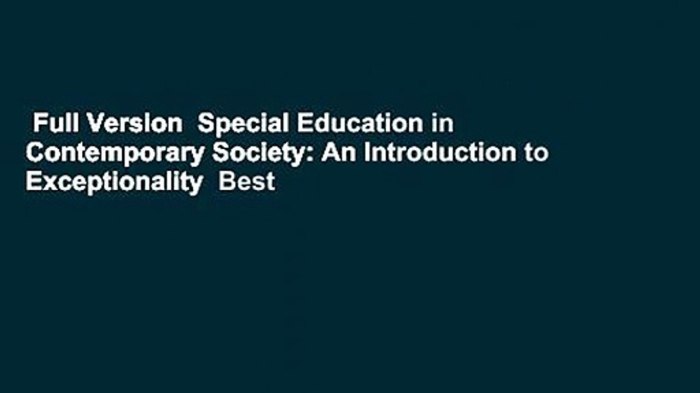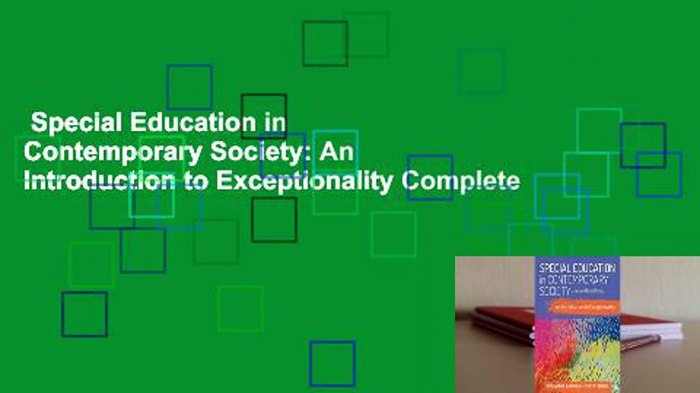Special education in contemporary society: an introduction to exceptionality has become an increasingly prominent field, with educators and policymakers seeking to understand and address the unique needs of exceptional students. This comprehensive guide provides a foundational understanding of special education, exploring its historical roots, legal framework, and diverse range of exceptionalities.
Through an engaging exploration of assessment, identification, and educational approaches, this guide empowers readers to navigate the complexities of special education and contribute to the creation of inclusive and equitable learning environments.
This guide delves into the social and emotional development of exceptional students, highlighting the challenges they face and the strategies that can be employed to promote their well-being. It also examines the critical transition from school to adulthood, emphasizing the importance of preparing students for post-school success.
By exploring emerging trends and future directions in special education, this guide provides a roadmap for continued innovation and improvement in the field.
Understanding Special Education
Special education refers to specialized educational services designed to meet the unique needs of students with disabilities. Its purpose is to provide tailored instruction and support to ensure that these students have equal access to education and reach their full potential.
History of Special Education Services
The history of special education services can be traced back to the early 19th century with the establishment of specialized institutions for students with disabilities. Over time, there has been a shift towards inclusive education, with a focus on providing support and services within general education settings.
Legal and Ethical Foundations of Special Education
Special education services are guided by legal and ethical frameworks. The Individuals with Disabilities Education Act (IDEA) mandates the provision of free and appropriate public education to all students with disabilities. Ethical principles emphasize the rights of individuals with disabilities to receive a quality education and to be treated with dignity and respect.
Categories of Exceptionality: Special Education In Contemporary Society: An Introduction To Exceptionality
There are various categories of exceptionality recognized in special education, each with its unique characteristics, strengths, and challenges.
Intellectual Disability
- Characterized by significant limitations in intellectual functioning and adaptive behavior.
- Prevalence: Approximately 1-3% of the population.
- Strengths: Warmth, empathy, and loyalty.
- Challenges: Difficulty with abstract reasoning, problem-solving, and communication.
Autism Spectrum Disorder (ASD)
- Characterized by social communication deficits, repetitive behaviors, and restricted interests.
- Prevalence: Approximately 1 in 54 children.
- Strengths: Focus, attention to detail, and creativity.
- Challenges: Difficulty with social interactions, communication, and sensory processing.
Assessment and Identification
Identifying students with special needs involves a comprehensive assessment process that includes observation, testing, and other evaluation methods.
Role of Observation
Observation is an essential tool for gathering information about a student’s behavior, skills, and learning style in different settings.
Role of Testing
Standardized tests and other assessments are used to measure a student’s cognitive abilities, academic achievement, and developmental skills.
Importance of Early Identification and Intervention
Early identification and intervention are crucial for students with exceptionalities. Early support can help mitigate potential challenges and promote optimal development.
Educational Approaches

Special education employs various educational approaches to meet the unique needs of students with exceptionalities.
Individualized Education Programs (IEPs)
IEPs are legal documents that Artikel a student’s specific educational needs, goals, and services.
Differentiated Instruction, Special education in contemporary society: an introduction to exceptionality
Differentiated instruction involves tailoring instruction to meet the individual learning styles and needs of students within a diverse classroom.
Role of Technology
Technology can provide assistive devices, educational software, and other tools to support students with special needs.
Collaboration and Partnerships
Collaboration is essential for providing comprehensive services to students with exceptionalities.
Role of Interdisciplinary Teams
Interdisciplinary teams bring together professionals from various disciplines (e.g., special educators, general educators, therapists) to provide a holistic approach to supporting students.
Importance of Partnerships
Partnerships between schools, families, and community organizations are crucial for ensuring the success of students with special needs.
Social and Emotional Development
Students with exceptionalities may face unique social and emotional challenges.
Challenges
- Difficulty with social interactions and communication.
- Emotional regulation issues.
- Low self-esteem.
Strategies for Support
- Social skills training.
- Self-regulation strategies.
- Building positive relationships.
Transition and Post-School Outcomes

Transition planning is essential for students with special needs as they prepare for adulthood.
Transition Planning Process
Transition planning involves assessing a student’s needs and developing a plan for post-school employment, higher education, or independent living.
Importance of Preparation
Preparing students for post-school outcomes requires a focus on functional skills, vocational training, and social-emotional development.
Future Directions in Special Education

Special education is constantly evolving to meet the changing needs of students with exceptionalities.
Emerging Trends
- Increased use of technology.
- Focus on evidence-based practices.
- Emphasis on collaboration and partnerships.
Challenges
- Ensuring equitable access to services.
- Addressing the needs of students with complex disabilities.
- Preparing teachers to meet the diverse needs of students.
Essential FAQs
What is the purpose of special education?
Special education is designed to provide specialized instruction and support to students with disabilities who require individualized educational programs to access and benefit from general education.
What are the different types of exceptionalities?
Exceptionalities encompass a wide range of disabilities, including learning disabilities, intellectual disabilities, autism spectrum disorder, emotional and behavioral disorders, physical disabilities, and sensory impairments.
How are students identified for special education services?
Students are identified for special education services through a comprehensive evaluation process that includes observation, testing, and other assessment methods.
What is an individualized education program (IEP)?
An IEP is a legal document that Artikels a student’s unique educational needs and the specific services and supports required to meet those needs.
What is the role of collaboration in special education?
Collaboration between special educators, general educators, parents, and other professionals is essential for providing comprehensive services to students with exceptionalities.